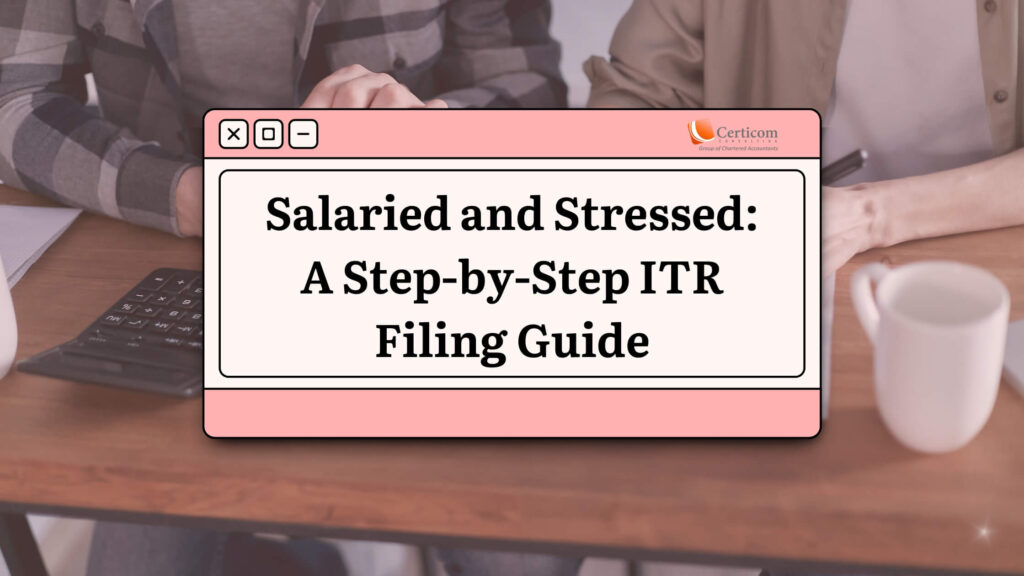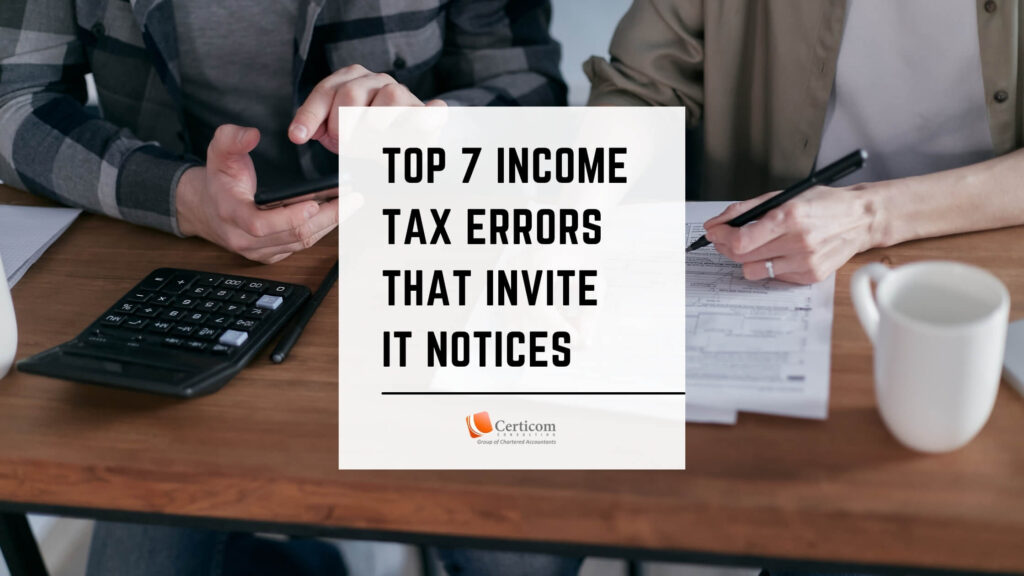Salaried and Stressed: A Step-by-Step ITR Filing Guide

Filing your Income Tax Return (ITR) is more than a statutory requirement—it’s a crucial step toward responsible financial management. For salaried individuals, filing returns not only ensures legal compliance under the Income Tax Act, 1961, but also helps in claiming refunds, maintaining financial records, and staying eligible for loans and visas.
Who Needs to File ITR?
According to Section 139(1) of the Income Tax Act, every individual whose total income exceeds the basic exemption limit must file an income tax return.
Exemption Limits for AY 2024–25
| Age Group | Basic Exemption Limit |
|---|---|
| Below 60 years | ₹2.5 Lakhs |
| 60 to 80 years (Senior Citizens) | ₹3 Lakhs |
| 80 years and above (Super Seniors) | ₹5 Lakhs |

In addition, return filing becomes mandatory if you:
Want to claim a refund of TDS or advance tax
Are a director in a company
Hold foreign assets or income
Have deposited ₹1 crore or more in a bank account
Incurred ₹2 lakh or more on foreign travel (Rule 12AB)
Which ITR Form Should Salaried Individuals Use?
The appropriate ITR form depends on your income composition and other financial details:
ITR-1 (Sahaj): For resident individuals with total income up to ₹50 lakh from salary, one house property, and other sources (excluding lottery winnings or race income)
ITR-2: For income above ₹50 lakh, or if you have capital gains, foreign income/assets, or multiple properties
Understanding Salary Income Components
Under Section 17(1) of the Income Tax Act, salary includes:
Basic salary
Dearness allowance (DA)
House Rent Allowance (HRA)
Leave Travel Allowance (LTA)
Perquisites (as per Sec 17(2))
Bonus/Commission
Pension, Gratuity, etc.
Note: Salary is taxable on the earlier of due or receipt basis.
Key Deductions for Salaried Taxpayers
Salaried employees can avail of several deductions under the Income Tax Act:
| Section | Deduction Type | Maximum Limit |
|---|---|---|
| 16(ia) | Standard Deduction | ₹50,000 |
| 80C | LIC, PPF, EPF, ELSS, etc. | ₹1.5 Lakhs |
| 80D | Medical Insurance | ₹25,000 – ₹50,000 |
| 80CCD(1B) | Additional NPS Contribution | ₹50,000 |
| 80E | Education Loan Interest | No Limit |
| 80TTA | Interest on Savings Account | ₹10,000 |
Section 87A Rebate: Individuals with net taxable income ≤ ₹5 lakh are eligible for a rebate of up to ₹12,500 (effectively zero tax).
Tax Slabs for AY 2024–25
Old Tax Regime
| Income Slab | Tax Rate |
|---|---|
| 0 – ₹2.5 Lakhs | Nil |
| ₹2.5L – ₹5L | 5% |
| ₹5L – ₹10L | 20% |
| Above ₹10L | 30% |
New Tax Regime (Default) – Section 115BAC(1A)
| Income Slab | Tax Rate |
|---|---|
| 0 – ₹3 Lakhs | Nil |
| ₹3L – ₹6L | 5% |
| ₹6L – ₹9L | 10% |
| ₹9L – ₹12L | 15% |
| ₹12L – ₹15L | 20% |
| Above ₹15L | 30% |
⚠️ Important: Under the new regime, most deductions (80C, 80D, HRA, LTA) are not allowed, except:
₹50,000 Standard Deduction
NPS (Employer’s contribution) – Section 80CCD(2)
Agniveer Corpus – Section 80CCH
Old vs New Regime – A Real Example
Case: Mr. Arjun (Age: 35)
Gross Salary: ₹9,00,000
Investments: ₹1.5L in PPF, ₹50K in NPS
HRA Exemption: ₹1L
Medical Insurance Premium: ₹25,000
Under Old Regime:
Deductions & exemptions reduce taxable income to ₹5,25,000
Tax before rebate: ₹17,500
Less: ₹12,500 rebate under 87A
Final Tax: ₹5,000 + 4% cess = ₹5,200
Under New Regime:
No deductions except standard deduction
Taxable income: ₹8,50,000
Tax: ₹40,000 + 4% cess = ₹41,600
➡️ Conclusion: Old regime is beneficial due to available deductions.
Step-by-Step Guide to File Your ITR Online
Visit: https://www.incometax.gov.in
Log in using PAN credentials
Navigate to e-File → Income Tax Return → File Now
Choose AY 2024–25, Individual, and Online Mode
Select the correct ITR Form (ITR-1 or ITR-2)
Verify pre-filled details using Form 16 and Form 26AS
Choose your tax regime (Old or New)
Enter eligible deductions if opting for old regime
Validate tax computation
Submit return and e-verify via Aadhaar OTP, Net Banking, Demat, or DSC

Important Deadlines & Penalties
| Action | Due Date |
|---|---|
| Regular Return (Non-Audit Cases) | 1st July 2025 |
| Belated Return Filing | 31st December 2025 |
Late Filing Fee (Section 234F):
₹5,000 if income > ₹5 Lakhs
₹1,000 if income ≤ ₹5 Lakhs
Final Checklist Before Filing
✅ Reconcile Form 16 with Form 26AS, AIS, and TIS
✅ Report all sources of income: salary, interest, capital gains, etc.
✅ Choose the tax regime carefully after benefit comparison
✅ File your return before the due date to avoid late fees and interest
Filing your ITR can seem overwhelming, but with proper understanding and timely action, you can sail through it smoothly. If in doubt, consult a Chartered Accountant or tax advisor to ensure accurate filing.
Related Post
Top 7 Income Tax Errors That Invite IT Notices
Resident’s Guide to Buying NRI Property in India
Book A One To One Consultation Now For FREE
How can we help? *



